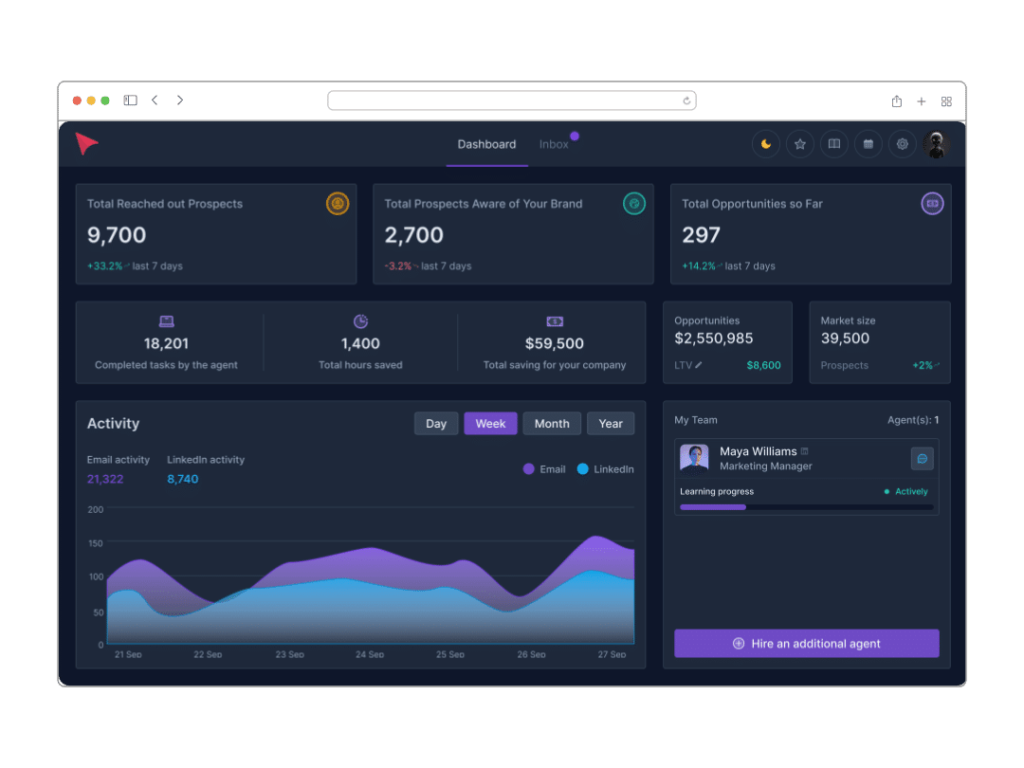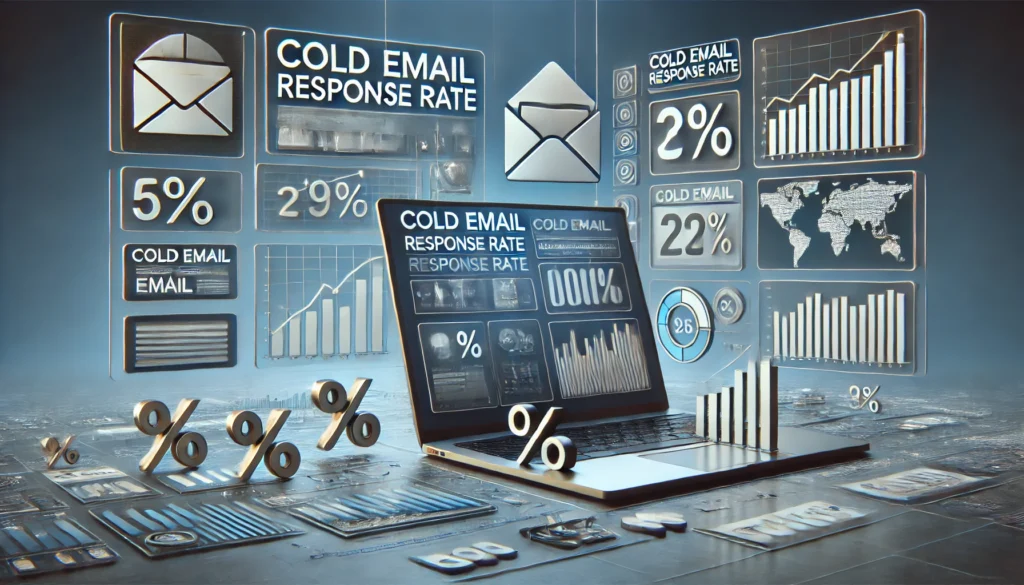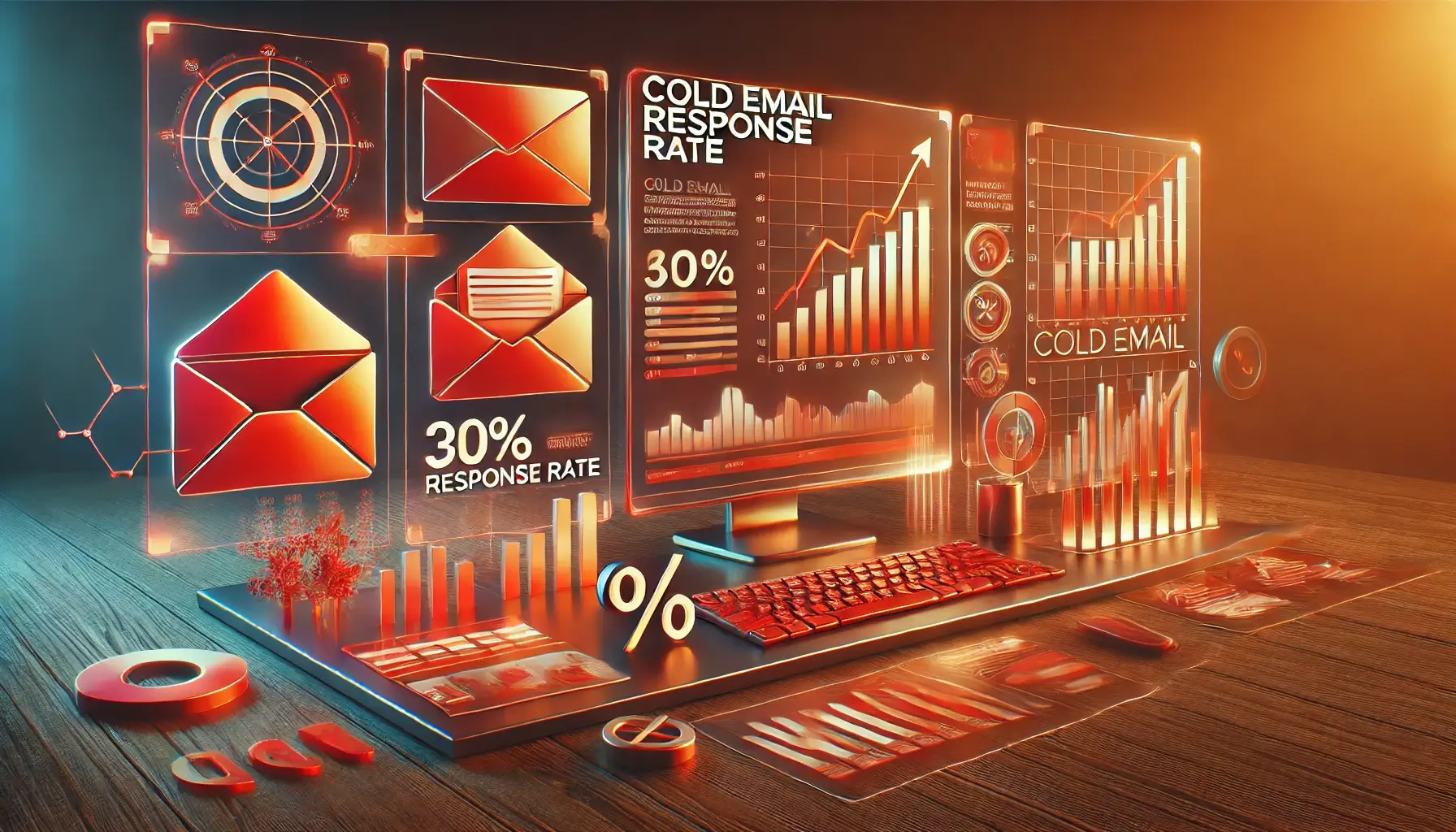Have you ever thought about why some emails sit unread in packed inboxes while others get quick replies? Perhaps the secret is in the craft of cold emailing. Though just 21% of cold emails are ever opened, a startling 306.4 billion emails are sent daily in 2024. But don’t let that deter you; cold emailing can transform your company with the correct strategy.
What then precisely is cold emailing? Basically, it’s contacting possible clients or partners you don’t yet know. Consider it as a digital handshake, presenting your company and yourself to someone fresh. From behind your computer screen, it’s like entering a room full of strangers and starting up a discussion.
Why should 2024 cold emailing matter to you? First of all, it’s a reasonably priced approach for the expansion of your company. Given 59% of marketers claim email is their main source of return on investment, a well-written cold email can open doors otherwise closed.
The truth is, though, not all cold emails are produced equal. Your message has to be unique in a world where the normal person gets 121 emails every day. We are here to assist you maximize your cold email reply rate with some basic yet powerful changes. All set to make those unread messages relevant connections? Allow us to delve right in.
Understanding Cold Email Response Rates
Average reply rates across industries
Cold email response rates can vary wildly depending on your industry. Here’s a quick snapshot:
– Tech and software: 15-22%
– Marketing and advertising: 12-18%
– Finance and real estate: 10-15%
– Retail and e-commerce: 8-13%
– Healthcare and pharmaceuticals: 7-11%
Remember, these are just average response rates. Your mileage may vary, and that’s okay!
Defining good vs. bad response rates in 2024
So, what’s considered a “good” response rate in 2024? Here’s a simple breakdown:
– Excellent: 30% or higher
– Good: 15-30%
– Average: 10-15%
– Poor: 5-10%
– Needs improvement: Below 5%
Keep in mind, even a 5% response rate can be valuable if you’re reaching out to high-value prospects. Quality often trumps quantity in cold emailing.
How to calculate the cold email response rate
Calculating your response rate is easier than you might think. Here’s the formula:
Response Rate = (Number of Responses / Number of Emails Sent) x 100
For example, if you send 100 emails and get 12 responses, your response rate is:
(12 / 100) x 100 = 12%
Pro tip: Don’t count auto-replies or out-of-office messages as responses. Focus on genuine, human replies to get an accurate picture of your campaign’s performance.
Timing: A Critical Factor in Cold Email Marketing
Ever heard the phrase “timing is everything”? When it comes to cold emails, it couldn’t be more true. Let’s dive into the nitty-gritty of when to hit that send button for maximum impact.
Best times to send cold emails
Believe it or not, there are “golden hours” for cold emailing:
– Weekdays are your best bet. Tuesdays and Thursdays often see higher email open rates.
– Time of day matters. Aim for 10-11 AM or 2-3 PM in the recipient’s time zone. People are often checking emails after settling into work or post-lunch.
– Avoid Mondays (too busy) and Fridays (weekend mode activated).
❗️Remember, these are general guidelines. Your specific audience might have different habits, so don’t be afraid to experiment!
Frequency considerations
How often should you reach out? It’s a balancing act:
– Initial email: Day 1
– First follow-up: 2-3 days after
– Second follow-up: 4-5 days after the first follow-up
– Final attempt: 7-8 days after the second follow-up
The key is persistence without being pesky. After 3-4 attempts with no response, it’s usually time to move on.
Impact of timing on response rates
Sending your cold email at the right time can boost your response rates by up to 30%! Here’s why timing is so crucial:
– Inbox position. Emails sent at optimal times are more likely to be at the top of the inbox when the recipient checks.
– Mental state. Catching people when they’re in “work mode” increases the chances of engagement.
– Reduced competition. Sending when email volume is lower means less competition for attention.
Remember; timing is about knowing the routines and habits of your audience, not only about the clock. A well timed email can make all the difference between a brief response and radio silence.
In the following part, we will discuss strategies to make your emails attractive regardless of their landing point in the inbox. All set to match your sending approach with the schedules of your prospects?
Want to know more? Read also – Cold Email Success: Best Time to Send Cold Emails [AI Insights]
Techniques to Increase Response Rates
Ready to supercharge your cold email game? Let’s dive into some tried-and-true techniques that’ll have your prospects hitting “reply” in no time.
1. Crafting compelling subject lines
Your subject line is your first impression. Make it count!
👉 Keep it short
Aim for 30-50 characters. “Quick question about [Company Name]’s growth” packs a punch.
👉 Use curiosity
“The strategy that boosted [Competitor]’s sales by 50%” makes people want to know more.
👉 Personalize
“[Mutual Connection] suggested I reach out” adds instant credibility.
👉 Avoid spam triggers
Steer clear of ALL CAPS, excessive punctuation!!!, and words like “free” or “limited time offer.”
Remember, a great subject line makes opening your email feel like unwrapping a gift.
📜 Related – 25 Worked Cold Email Subject Lines Proven by AI
2. Personalizing email content
Nobody likes to feel like just another name on a list. Here’s how to make your emails feel tailor-made:
1. Do your homework – reference recent company news or achievements.
2. Use their language – mirror the tone and style from their website or LinkedIn posts.
3. Show you understand their challenges: “I noticed [Company] is expanding into [New Market]. Here’s how we helped similar businesses succeed…”
4. Name drop (tastefully) – mention mutual connections or industry events you both attended.
3. Creating clear and concise call-to-actions (CTAs)
Don’t leave your reader wondering, “So what?” Make your CTA crystal clear:
1. Be specific: “Let’s schedule a 15-minute call this week” beats “Hope to hear from you soon.”
2. One CTA per email: Multiple asks can overwhelm. Focus on your primary goal.
3. Make it easy: “Click here to book a time that works for you” with a scheduling link removes friction.
4. Create urgency (without being pushy): “I have 3 slots open this week for a quick chat. Shall we lock one in?”
4. A/B testing email elements
Never stop improving! A/B testing helps you fine-tune your approach:
1. Test one element at a time – subject lines, opening lines, CTAs, or send times.
2. Use a significant sample size – at least 100 emails per variant for meaningful results.
3. Track and analyze – use tools to monitor email open rates, click-through rates, and response rates.
4. Implement winning strategies – once you find what works, roll it out to your larger campaigns.
5. Warm up your domain before starting a cold email campaign
Don’t dive into the deep end right away. Warm up your email domain to boost deliverability:
- Start slow: Begin with 20-40 emails a day and gradually increase over 2-4 weeks.
- Mix it up: Send to a combination of new and existing contacts.
- Engage naturally: Encourage replies, mark important emails, and move some out of spam if they land there.
- Use authentication: Set up SPF, DKIM, and DMARC records for your domain.
- Monitor your sender reputation: Use tools like MxToolbox to check your domain health regularly.
- Use email deliverability services, like Warmy.io, to do it automatically.
Remember, a warm domain is like a well-oiled machine – it runs smoother and performs better.
📜 Related – Enhancing B2B Cold Email Conversion Rates: Proven Strategies with AI Tools
The Power of Follow-ups
Ever get the sensation as though your first email disappeared into thin air? Not to panic; follow-ups help in this regard. Let’s look at how to become experts in the follow-up without coming across as demanding.
1. Importance of follow-up emails
Here’s a jaw-dropping stat: 80% of sales require 5 follow-up emails after the initial contact. Yet, 44% of salespeople give up after just one follow-up. Here’s why follow-ups are your secret weapon:
Timing is everything
Your first email might have caught them at a bad time. A follow-up gives you another shot.
Shows persistence
It demonstrates your genuine interest in connecting.
Jogs memory
People are busy. A gentle reminder can bring your offer back to the top of their mind.
Increases visibility
Each follow-up is another chance to appear in their inbox and grab attention.
2. Effective follow-up strategies
Now, let’s talk tactics:
1. Vary your approach:
– Email 1: “Just checking in on my previous email…”
– Email 2: “I thought you might find this relevant article interesting…”
– Email 3: “I have an idea that could help with [specific challenge]…”
2. Add value each time:
– Share a relevant case study
– Offer a quick tip related to their industry
– Mention a mutual connection or shared interest
3. Use the “bump” technique:
– Simply forward your original email with a short note: “Bumping this to the top of your inbox. Thoughts?”
4. Try different channels:
– If email isn’t working, consider a LinkedIn message or even a phone call.
Balancing persistence with respect for recipient’s time
Walking the line between persistent and pestering is crucial. Here’s how to stay on the right side:
- Start your follow-ups three to four days, then a week, then two weeks.
- Simplicity is key. Keep follow-ups less than your first email.
- Offer a simple out: “Don’t worry if this isn’t right now a top concern. Would it be acceptable if I turned around in one month?”
- Should someone ask you not to get in touch with them, honor that.
- Know when you should fold ’em. Usually it’s time to move on after three to four tries without any reaction.
Pro tip: Use a simple numbering system in your subject lines to keep track:
– “Following up on our conversation (1/3)”
– “One last check-in about [Topic] (2/3)”
– “Final note regarding [Their Company] (3/3)”
This shows transparency and gives a clear end point to your outreach.
Recall that the purpose of follow-ups is to catch someone at the appropriate moment with the appropriate message, not to wear someone out. These techniques help you to nurture possible relationships rather than only send follow-ups.
📜 Interested in details? Check out our article – Cold Email Follow-Up: Write Effective Follow-Ups with Templates & AI
Leveraging AI in Cold Email Marketing
Ever wanted a relentless, super-bright assistant to manage your cold email campaigns? Thanks to artificial intelligence, that is not only a pipe dream now. With an eye toward a game-changing technology called AnyBiz, let’s explore how artificial intelligence is transforming cold email marketing.
1. Introduction to AI tools for cold emailing

Meet AnyBiz, your new AI-powered sales team. It’s not just another email tool – it’s a comprehensive platform that’s redefining B2B lead generation. Here’s what it brings to the table:
- AI Sales Agents. These virtual team members work 24/7, crafting personalized outreach across multiple channels.
- Smart Decision-Making: AnyBiz analyzes over 10,000 data points per hour to make billions of strategic decisions.
- Multi-Channel Engagement: It doesn’t just stick to email – AnyBiz reaches out via LinkedIn and Twitter too.
Imagine waking up to a full pipeline of warm leads, all nurtured while you slept. That’s the AnyBiz promise.
2. Benefits of AI-powered personalization at scale
With AnyBiz, gone are the days of generic, one-size-fits-all cold emails. Here’s how it takes personalization to the next level:
1. Tailored Outreach. AnyBiz creates unique sequences for each prospect, considering their industry, role, and behavior.
2. Perfect Timing. The AI determines the best time to send emails, increasing open and response rates.
3. Automated Follow-ups. No lead falls through the cracks with AnyBiz’s smart follow-up system.
4. Personalized Landing Pages. Every prospect gets their own custom page, making them feel truly valued.
Plus, AnyBiz’s brand awareness feature boosts your visibility by engaging on LinkedIn – posting, liking, and commenting on your behalf.
All set to boost your cold email marketing with artificial intelligence? AnyBiz gives a 7-day free trial with all feature access. None of strings connected! This is your opportunity to directly witness B2B lead generation’s future. Try it to find out how many excellent leads you can create in one week.
Industry-Specific Cold Email Strategies

One size doesn’t fit all in the world of cold emailing. Let’s explore how to tailor your approach to different industries and make your emails resonate with your specific audience.
1. Tailoring approaches for different sectors
1. Tech and Software:
– Focus on innovation and efficiency gains
– Use tech-savvy language and showcase your product’s unique features
– Example AnyBiz approach: “AnyBiz’s AI agents analyzed your tech stack and found 3 areas where our solution could boost your efficiency by 30%.”
2. Finance and Real Estate:
– Emphasize ROI and cost savings
– Use data-driven arguments and case studies
– Example AnyBiz approach: “AnyBiz identified 50 high-net-worth individuals in your area actively looking for investment properties. Let’s connect them with your listings.”
3. Healthcare and Pharmaceuticals:
– Highlight patient care improvements and regulatory compliance
– Use empathetic language and focus on outcomes
– Example AnyBiz approach: “AnyBiz’s AI spotted a trend in patient feedback about wait times. Here’s how our scheduling solution addresses this issue.”
4. Marketing and Advertising:
– Showcase creativity and campaign performance metrics
– Use visually appealing emails with strong CTAs
– Example AnyBiz approach: “AnyBiz analyzed your competitors’ social media engagement. We’ve drafted 5 campaign ideas to outperform them by 25%.”
5. Retail and E-commerce:
– Focus on customer experience and sales growth
– Use personalized product recommendations
– Example AnyBiz approach: “AnyBiz identified a gap in your product range that’s driving 30% of your visitors to competitor sites. Let’s discuss how to plug this gap.”
2. Tips for adapting strategies to your specific industry
1. Know your audience:
– Use AnyBiz’s IP recognition feature to identify companies visiting your website
– Tailor your language to match industry jargon and pain points
2. Leverage industry trends:
– AnyBiz can scan industry news and incorporate relevant trends into your emails
– Example: “With the recent changes in [Industry Regulation], AnyBiz has prepared a compliance strategy for your review.”
3. Showcase relevant expertise:
– Use AnyBiz’s AI to craft industry-specific content for your LinkedIn posts
– Share these insights in your cold emails to establish credibility
4. Personalize at scale:
– AnyBiz’s AI sales agents can create unique sequences for each industry
– Example: For SaaS companies, focus on user adoption rates; for manufacturing, emphasize supply chain efficiency
5. Time your outreach strategically:
– Use AnyBiz to identify industry-specific peak engagement times
– Example: Financial services might be more responsive early morning, while creative industries might engage better in the afternoon
6. Utilize multi-channel approach:
– AnyBiz can engage prospects across email, LinkedIn, and Twitter
– Tailor your message on each platform to industry preferences
7. Continuous learning and optimization:
– AnyBiz’s AI constantly analyzes response rates and adjusts strategies
– Example: “Our AI noticed a 15% higher engagement when we mention [Industry Award] in emails to [Your Industry] prospects.”
Remember, the key to successful industry-specific cold emailing is to show that you understand the unique challenges and opportunities in your prospect’s field. With AnyBiz, you’re not just sending emails – you’re starting relevant, value-driven conversations that resonate with your target industry.
Main Problems That May Cause Low Cold Email Response Rates
Let’s dive into the main reasons why you might be seeing a low cold email response rate. Understanding these issues is the first step to fixing them and boosting your success rate.
1. Poor email list quality
– Outdated or incorrect contact information
– Targeting the wrong decision-makers
– Using purchased lists instead of building organic ones
2. Weak subject lines
– Generic or spammy-sounding subjects
– Failing to pique curiosity or offer value
– Too long or unclear
3. Lack of personalization
– Using a one-size-fits-all approach
– Not addressing recipient’s specific pain points
– Failing to show you’ve done your homework on their company
4. Unclear or weak call-to-action (CTA)
– Vague or confusing next steps
– Asking for too much too soon
– Not providing a compelling reason to act
5. Poor timing
– Sending at suboptimal times of day or week
– Not considering the recipient’s time zone
– Failing to align with the prospect’s buying cycle
6. Overly long or complex emails
– Information overload in the first contact
– Not getting to the point quickly
– Using jargon or complex language
7. Lack of value proposition
– Focusing on features instead of benefits
– Not clearly explaining how you can solve their problems
– Failing to differentiate from competitors
8. Poor email deliverability
– Emails landing in spam folders
– Using triggering words that activate spam filters
– Not warming up your email domain properly
9. Inconsistent follow-up
– Giving up after one or two attempts
– Following up too aggressively
– Not adding new value in follow-up emails
10. Ignoring mobile optimization
– Not considering how emails appear on mobile devices
– Using large images that don’t load properly on mobile
– Having CTAs that are difficult to click on small screens
11. Lack of social proof
– Not including testimonials or case studies
– Failing to mention relevant clients or awards
– Not leveraging mutual connections or referrals
12. Poor email design and formatting
– Walls of text without proper formatting
– Using fonts or colors that are hard to read
– Including too many images or attachments
Here’s where a tool like AnyBiz can really shine. It addresses many of these issues automatically:
- AnyBiz’s AI analyzes over 10,000 data points per hour to determine the best time to send emails, solving the timing issue.
- Its personalization at scale ensures each prospect receives a tailored message, addressing their specific pain points.
- The multi-channel approach (email, LinkedIn, Twitter) increases your chances of reaching the prospect where they’re most responsive.
- AnyBiz’s email domain warming feature helps improve deliverability, keeping you out of spam folders.
- The AI-driven follow-up system ensures consistent, value-adding follow-ups without being overly aggressive.
Remember, improving your cold email reply rateis an ongoing process. It requires continuous testing, learning, and refining. With AnyBiz, you get a powerful ally in this process, automating much of the heavy lifting and allowing you to focus on crafting compelling messages and building relationships.
Boost Your Cold Email Results: Quick Wins
Want to see your response rates soar? Here’s your action plan:
- Keep it clean. Regularly update your email list. Remove bounces, unsubscribes, and inactive contacts. A clean list means better deliverability and more responses.
- Prove you’re legit. Set up SPF, DKIM, and DMARC. These authentication protocols tell inbox providers you’re trustworthy, keeping you out of spam folders.
- Think mobile-first. Over half of emails are opened on phones. Make sure your emails look great and function well on small screens. Short paragraphs, clear CTAs, and minimal images are key.
- Show you’re the real deal. Sprinkle in social proof. A brief customer quote or a mention of a recent award can work wonders. It builds trust and shows you’ve got the chops to back up your claims.
Conclusion
You’ve got the tools, now it’s time to act. Remember, personalization is king, timing is crucial, and follow-ups are your secret weapon. But don’t stop there – keep testing, tweaking, and improving. Every industry and audience is unique, so find what works best for you.
Ready to see these strategies in action? AnyBiz’s AI-powered platform can implement all these tactics and more, automatically. From personalized outreach to perfect timing, it’s like having a tireless sales team working 24/7.
📜 Related articles:
FAQ
The average open rate for cold emails typically ranges from 15% to 25%, depending on the industry and the quality of the email list.
A good response rate for cold emails is around 1% to 5%. Higher rates are often achieved with highly targeted lists and personalized content.
Effective strategies for email outreach include segmenting your audience, personalizing messages, optimizing send times, and consistently following up.
Successful sales emails are personalized, concise, and direct, with a clear value proposition and a compelling call to action.
Look for features like automation, personalization capabilities, integration with other tools, analytics for tracking performance, and compliance with spam regulations.
A good reply rate for cold emails can vary, but generally, rates between 3% and 10% are considered effective, depending on the campaign's goals and the industry.


